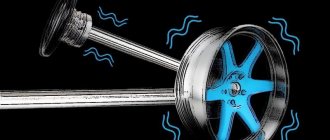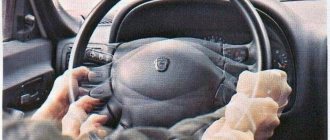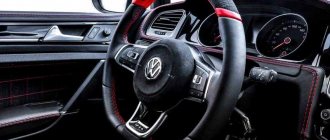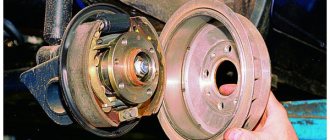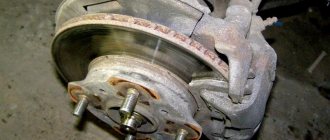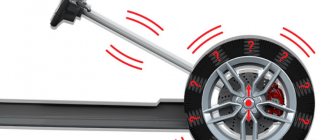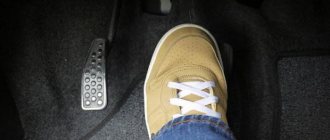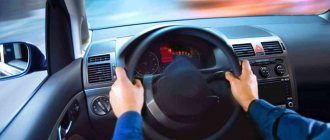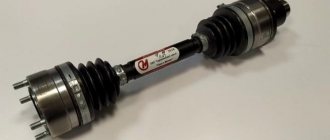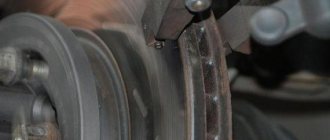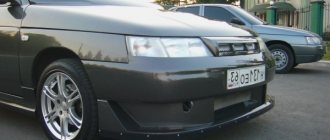One of the most unpleasant effects indicating a malfunction of the car braking system is the beating of the brake pedal. This cannot be said to be a fatal defect, but in a real traffic situation it can negatively affect traffic safety. The beating of the brake pedal is manifested in the fact that while the car is braking, the driver feels the pedal begin to vibrate, and the greater the pressing force, the more powerful the vibrations. What are the reasons for this effect, and can it be eliminated? We will examine these questions in this article.
Design and principle of operation of the braking system
Diagram of the car brake system: 1 - brake disc; 2 — front wheel brake caliper; 3 - front contour; 4 - main cylinder; 5 — reservoir with brake fluid level sensor; 6 — vacuum brake booster; 7 — pusher; 8 — pedal; 9 — brake light switch; 10 — brake pads of the rear wheels; 11 — brake cylinder of the rear wheels; 12 - rear contour; 13 — rear axle axle housing; 14 — load spring; 15 — pressure regulator; 16 — rear cables; 17 — equalizer; 18 — front cable; 19 — parking brake handle; 20 — indicator of emergency drop in brake fluid level; 21 — parking brake warning switch; 22 — brake pads of the front wheels;
Before considering the reasons for the brake pedal beating, it is worth recalling how the braking system as a whole is designed. The simplest one consists of the following components:
- brake pedal;
- master brake cylinder;
- brake fluid reservoir;
- brake circuits (hoses, tubes);
- working brake cylinders.
This is a list of the main elements that make up a typical braking system. Modern cars, in addition to the specified parts, are also equipped with vacuum brake boosters and an ABS anti-lock braking system.
Conceptually, a car's braking system is a simple hydraulic system and operates on the same principle. When you press the pedal, muscle force is transferred to the master cylinder, which converts this mechanical energy into hydraulic energy. The pressure of the brake fluid in the brake circuits increases, and it acts on the working cylinders, which in turn press the pads against the brake discs and/or drums of all four wheels. As a result, the vehicle first slows down and then stops. As you can see, the principle of operation is simple.
Causes of vibration when braking
Worn, rusty, dirty or weakened brake pads cannot effectively grip the surface of the brake rotor. Pads can also become contaminated with oil, brake fluid, dirt, road salt or even grease due to careless installation.
Any of these reasons can cause the steering wheel to shake when braking. Please note: While there are ways to clean dirty brake pads, it is best to replace them.
Dry, corroded, defective, missing brake caliper fasteners (especially the caliper guide pins, which prevent the caliper from running smoothly and smoothly) will cause the brake caliper to seize and bend, meaning it will not be able to press the pads straight to the surface of the brake rotor.
Also, the above reasons may incorrectly press the pads against the rotors, which can lead to their overheating, causing them to vibrate during braking. Brake pads operating with a faulty caliper may wear faster and unevenly.
You can replace the pads yourself, but properly cleaning and lubricating rusty caliper guide pins is a job best left to the professionals.
see also
Top 12 common car problems that drivers encounter most often
Brake pedal runout
Since the car's braking system is essentially a hydraulic system, it has all the same features. In particular, as in any other hydraulics, the so-called reverse action is observed here, when the actuator returns mechanical energy received from the outside to the hydraulic cylinder. In most cases, it is this feature of hydraulics that causes the brake pedal to run out.
The pressing surfaces of the new brake discs are perfectly flat and the brake drums are perfectly round. Therefore, in the process of pressing the pads against them, there is no reverse impact on the working cylinders. The pads evenly compress the discs or are pressed against the drums. The car brakes smoothly and stops.
During the operation of the car, discs and drums wear out (erased), and unevenly. It is also common for discs and drums to become bent due to the high temperature generated during braking. This defect does not always appear, but only with a certain driving style - with a lot of frequent and sudden braking.
Steering wheel shakes and brake pedal vibrates
The rotors may indicate a problem if you feel the steering wheel shaking from side to side and the brake pedal pulsating up and down when braking.
A warped brake disc means that its surface tends to have uneven thickness. In this case, as the brake pads will move over a thinner or thicker area of the rotor when braking, the brake pedal will move up and down and the steering wheel will shake.
Also, severe shaking of the steering wheel may occur if the brake discs are rusty. In this case, the brake pads will be pressed against the rusted area of the rotor, which can result in rough braking. Severely rusted brake rotors can cause the brake pads to bind when stopping, causing the steering wheel to shake violently.
The surface of the brake discs must be absolutely flat. Please note that runout during braking can already appear if the thickness deviates by more than 0.08 mm or the thickness of a human hair.
If the disc surface is uneven, not only the brake pads will wear unevenly, but also the rotor itself (due to uneven heat dissipation that occurs when the brake disc pads are clamped).
Uneven wear on brake discs may also be due to the accumulation of rust or sand between the rotor and its mounting surface, causing the brake disc to vibrate.
Even minor defects or cracks in the rotor can cause shudder when braking. Serious brake disc failure can lead to wheel locking and loss of control of the vehicle while driving.
Overheating of the brake pads, as well as excessive tightening of the fastening nut, are the main (and frequent) causes of deformation of the brake discs. The environment you live in (salty air and road salts) can cause rotors to corrode.
Therefore, at your next maintenance, ask your auto mechanic to perform a visual inspection of the brake discs and pads. It is also advisable to measure their thickness.
Keep in mind that the surface of the brake discs can be sanded, but it all depends on how thick they are. If they are damaged or worn beyond the car manufacturer's specifications, they must be replaced. It is usually recommended to replace both brake discs on the same axle. It is also advisable to change the brake pads.
Other possible causes of brake pedal beating
The cause of pedal beating may be uneven wear not only of discs or drums, but also of pads. During the braking process, the friction composition from which the clamping elements are made heats up to a very high temperature. Despite the fact that asbestos, which is very resistant to strong heat, is used as a reinforcing material, even it is unable to withstand significant temperature effects. When the pad pressure pad thins unevenly, the reverse hydraulic effect described above occurs, which causes the brake pedal to run out.
Another reason for this effect is wear of the wheel bearing. This defect occurs quite rarely - probably only if the driver is careless and does not monitor the condition of the wheels. However, this cannot be excluded from the list of probable causes of brake pedal beating.
Sometimes the reason for the brake pedal beating is a simple looseness of the fasteners of the suspension components. True, the braking system has nothing to do with it - vibrations from loose bolts are transmitted first to the body, and then to the pedals. However, it looks like the brakes are faulty.
Steering
Here, the steering wheel may hit the steering wheel when braking due to worn or misadjusted steering elements.
At the same time, many believe that if there is play in the steering, the beating will be constant while driving, but we are considering the occurrence of impacts only when braking.
But this is not entirely true, and in order to understand how wear of the steering mechanism can affect the processes occurring when a car is braking, we should consider the theory a little.
The wheel always moves along the path of least resistance, and the higher the speed, the more difficult it is for it to change its trajectory.
When braking, the wheel slows down significantly, which can affect the trajectory of the latter.
If the steering mechanism is in good condition, it will keep the wheel in the desired path.
But if, as a result of wear, there is even a slight gap (1 mm), for example, between the rack and gear of a mechanism, then it will provide a lateral play of 3-4 mm on the wheel.
That is, the wheel will no longer be rigidly held, and it will be able to voluntarily change its trajectory within the range of available play, and this change is of a vibrational nature.
And from the wheel this vibration is transmitted to the mechanism and then to the steering wheel.
Therefore, if there is a beating in the steering wheel when braking, you should definitely check for play in:
- Rack and pinion pair;
- Steering tips;
- Cardan transmission of the steering column.
Using the HYUNDAI HD 72 as an example, it looks like this.
You should also definitely check the condition of the tie rods being attached to the rack.
Diagnostics
Checking brake discs with a micrometer;
So, we have looked at the probable causes of the brake pedal beating. How can we determine which of them played a negative role in this particular machine? This requires a comprehensive and thorough diagnosis. And it is best if the research is carried out in a specialized car service center.
As part of diagnostic activities, the following work is performed:
- checking the geometry of discs and drums;
- checking the pads;
- testing of wheel bearings;
- inspection of suspension fasteners.
The geometry of discs and drums is checked on a special stand, which accurately records the curvature of the flat pressure pad of the disc and the ellipticity of the inner surface of the drum. To determine the degree of pad wear, use a caliper or micrometer. The condition of the wheel bearings is determined using special equipment that determines the amount of camber and toe-in of the rotating wheels from the normal position.
Why does the steering wheel shake at speed?
Why does the steering wheel shake at a speed of 100 km/h? The reason for the steering wheel beating in this case is not as clear as in the case of braking. The problem is typical for both the domestic automobile industry and foreign-made cars. The following reasons for the steering wheel beating at high speed are identified:
- wheel imbalance (it’s worth checking the front wheels);
- disc deformation (disc deformation is caused by physical impact on it during an accident or is associated with the current properties of the road surface);
- the appearance of a “hernia” due to damage to the tire (even a slight deviation in the wheel geometry leads to vibration);
- dirt adhesion and ice formation (adhered lumps of dirt become ballast, which creates additional load on the axles);
- incorrect wheel alignment or worn hub cap;
- pressure difference in the wheels (difference in resistance creates vibration);
- malfunction of the front suspension (wear of shock absorbers or silent block);
- faulty CV joint.
If the steering wheel shakes when driving, there is no need to hesitate in solving the problem. In order to get rid of an unpleasant knocking noise, you need to conduct independent diagnostics and deal with the defect. How to do it?
- The rims and wheels should be cleaned of dirt and the pressure in the front tires checked;
- It is worth checking the wheels, discs and brake pads for integrity (presence of a hernia, worn out disc, worn out brake pads, etc.);
- If after completing the first two steps no problems are identified, then you should try swapping the wheels.
What to do if the brake pedal hits
Methods for eliminating the effect of brake pedal beating are obvious. This is a reduction to normal of all components, due to the malfunction of which it occurs. The simplest and often the only possible way is to replace the worn part with a new one. When discs or drums wear out, you need to buy new ones and install them in place of the old ones. However, the design features of these elements make it possible to avoid such a costly option.
The fact is that both discs and drums are made with some margin in thickness. Therefore, they can be processed (turned) on a metalworking machine, eliminating the curvature of the flat surface of the disks and the ellipticality of the drums. Just keep in mind that this method can only be used once. After one groove there will be no reserve in thickness left - the disk or drum will become so thin that it will bend even with relatively little heating. For drivers who practice an active driving style, it is generally not recommended to use machined discs and drums.
Video on the topic
Hello. This problem was caused by new front brake discs and pads. When you press the pedal, the brake hits and jerks. What could it be? Discs as in the photo. VAZ pads.
Comments 24
In short, the fact that the discs are moving and therefore the pedal is hitting is nonsense, I changed 3-4 pairs of driven discs and on all of them only the steering wheel is beating and only when braking and when you slow and smoothly brake, you feel it jerking... but at one fine moment when I changed the rear cylinders and the drums with the pads then started to hit the pedal and I still can’t understand what it depends on
Semi-discs and clean the seats there, even a small speck of dust will start to beat, and check the discs themselves and they may not be even, now everyone is stamping there is no edge, which is simply not defective
Normal disks, they are like that, no problems. Try turning them 180 degrees.
Try to clean the hub well before installing the disk; if this does not help, the disk is crooked.
I had these discs that didn’t come off for weeks and they burst.
Check the discs for runout! These discs are just pure crap! Just prepare for replacement in advance!
I read the advisers... why write if you don’t know the answer = If the steering wheel shakes when braking, the problem is in the front brake discs. If the pedal hits, and sometimes there is vibration in the body, the problem is in the rear brakes. I had a similar situation with the brakes. Everything was resolved by replacing the rear pads and drums. Look for the problem there.
if it hits the pedal, it’s not 100% that it’s drums! Discs also hit it!
I read the advisers... why write if you don’t know the answer = If the steering wheel shakes when braking, the problem is in the front brake discs. If the pedal hits, and sometimes there is vibration in the body, the problem is in the rear brakes. I had a similar situation with the brakes. Everything was resolved by replacing the rear pads and drums. Look for the problem there.
If this appeared to the author after replacing the discs and pads, then what does the rear brakes have to do with it? Coincidence - I don’t think so)
you need to take a dial indicator and check the runout of the disc first, then remove the disc and check the runout of the hub, and the runout of the disc must be checked on both sides
These wheels are normal, I installed them, I still drive them. They got stuck in puddles, etc., everything is ok. I would advise hanging them up in front, starting them, putting them in gear and watching how they spin for runout
Why does the steering wheel shake when braking?
A shaking steering wheel when braking is not only very annoying, it means that there is something wrong with the brake or steering system. Don't ignore it.
The feeling of the steering wheel shaking when braking can and should make you nervous. This usually indicates a problem with the brakes, one of your car's most important safety systems.
There are two types of braking systems: disc and drum. Since the 1980s, virtually all cars have come with front disc brakes as standard. Today, most cars are equipped with disc brakes on all four wheels.
Vibrations from worn brake drums are usually felt in the seats or rear of the car, but not in the steering wheel. However (when it comes to car breakdowns and repairs there is always the word “however”) there are several other possible reasons for the steering wheel shaking when braking.
Here's what you need to know.
